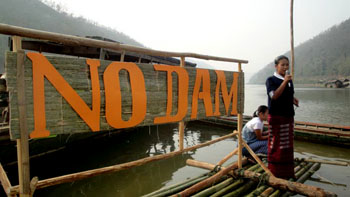Burma Rivers Network (BRN) issued a statement today urging an end to the construction of all dam projects in Burma. The release of the statement was timed to coincide with the International Day of Action for Rivers...
Burma Rivers Network (BRN) issued a statement today urging an end to the construction of all dam projects in Burma. The release of the statement was timed to coincide with the International Day of Action for Rivers.
 Ah Nan of BRN said that local people in Burma continue to face many difficulties, including forced relocation from their homes and forced labor on dam construction projects. As well, many of the proposed dam sites are still conflict zones. That is why BRN urges investors to stop water dam constructions and all related projects in Burma.
Ah Nan of BRN said that local people in Burma continue to face many difficulties, including forced relocation from their homes and forced labor on dam construction projects. As well, many of the proposed dam sites are still conflict zones. That is why BRN urges investors to stop water dam constructions and all related projects in Burma.
“Especially, I would like to mention about the dams the Burmese regime has built after the 2010 election. Local people have suffered from forced relocation and forced labor in these areas. There are some conflicts and tensions occurring between armed ethnic groups and the Burmese Army after the election. Karen people who live near the Salween River bank have to flee to Thailand because of gun battles. That’s why we call on Chinese, Indian, and Thai companies to stop the construction of all dams in Burma,” Ah Nan said.
There are total of 25 current dam projects in various stages of planning and construction in Burma. The majority of these dam projects are located in ethnic areas.
After the 2010 election, there were many gun battles between the Burmese Army and the armed Karen groups in the area. Thus, thousands of people who live near the Hatgyi Dam construction site have fled to Thailand.
According to BRN’s statement, there are many current dam projects in Shan, Kachin, and Karenni States. The Burmese Army has prepared to launch military offensives in these areas.
Likewise, local people who live along the Salween River bank in northern Karen State gathered and prayed according to their religious customs today in hopes of stopping the construction of more dams in their state.


